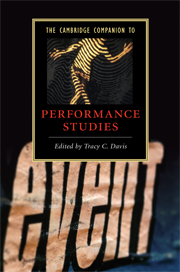Book contents
- Frontmatter
- Introduction: the pirouette, detour, revolution, deflection, deviation, tack, and yaw of the performative turn
- Part I Social polities: history in individuals
- Part II Body politics: the individual in history
- 7 Live and technologically mediated performance
- 8 Moving histories: performance and oral history
- 9 What is the “social” in social practice?: comparing experiments in performance
- 10 Live art in art history: a paradox?
- 11 Queer theory
- Further reading
- Index
7 - Live and technologically mediated performance
from Part II - Body politics: the individual in history
Published online by Cambridge University Press: 28 January 2009
- Frontmatter
- Introduction: the pirouette, detour, revolution, deflection, deviation, tack, and yaw of the performative turn
- Part I Social polities: history in individuals
- Part II Body politics: the individual in history
- 7 Live and technologically mediated performance
- 8 Moving histories: performance and oral history
- 9 What is the “social” in social practice?: comparing experiments in performance
- 10 Live art in art history: a paradox?
- 11 Queer theory
- Further reading
- Index
Summary
“Theatre is different from all other forms of theatrical presentation because it is live. . . . “At the heart of the theater experience, then, is the performer-audience relationship: the immediate, personal exchange; the chemistry and magic which gives theater its special quality.”” / I use this quotation, from an introductory course document prepared by Professor Kaoime Malloy, to stand for what I shall call the traditional view of live theatrical performance. The key word is immediate, which suggests that the traditional definition of live performance is founded on an opposition between the immediate and the mediated. From this perspective, the performer/audience relationship in film, for instance, is thought to be mediated by the camera and the rest of the filmic apparatus; in the theatre, by contrast, this relationship is seen as direct and unmediated. Such distinctions are largely commonsensical. Whereas stage actors can appropriately be considered the “authors” of their performances, film actors cannot. As the actor Willem Dafoe emphasized when I interviewed him, film actors basically provide raw material that is shaped into performances by directors and editors and therefore need not be as concerned about the through-lines of their performances as stage actors. Audiences witness theatre actors in the moment of performance but see performances by film actors only long after the actors have done their work. Stage acting is therefore temporally immediate to its audience in a way that film acting is not. Perhaps because of its disciplinary genealogy, performance studies often exhibits a bias toward live events and a resistance to including technologically mediated ones among its objects of inquiry. Performance studies is rooted in the fields of theatre studies, anthropology, sociology, folklore, speech, and oral interpretation, all of which take live events as their major points of reference, whether those events be aesthetic performances, cultural performances, rituals, or everyday behavior and conversations.
- Type
- Chapter
- Information
- The Cambridge Companion to Performance Studies , pp. 107 - 119Publisher: Cambridge University PressPrint publication year: 2008
- 12
- Cited by



